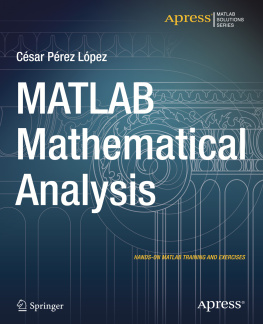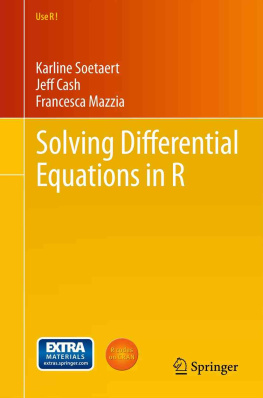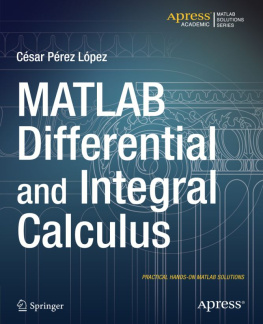Lopez C.P. - Differential Calculus using Mathematica
Here you can read online Lopez C.P. - Differential Calculus using Mathematica full text of the book (entire story) in english for free. Download pdf and epub, get meaning, cover and reviews about this ebook. genre: Science. Description of the work, (preface) as well as reviews are available. Best literature library LitArk.com created for fans of good reading and offers a wide selection of genres:
Romance novel
Science fiction
Adventure
Detective
Science
History
Home and family
Prose
Art
Politics
Computer
Non-fiction
Religion
Business
Children
Humor
Choose a favorite category and find really read worthwhile books. Enjoy immersion in the world of imagination, feel the emotions of the characters or learn something new for yourself, make an fascinating discovery.

Differential Calculus using Mathematica: summary, description and annotation
We offer to read an annotation, description, summary or preface (depends on what the author of the book "Differential Calculus using Mathematica" wrote himself). If you haven't found the necessary information about the book — write in the comments, we will try to find it.
Limits Of Sequences
Limits Of Functions. Lateral Limits
Continuity
Several Variables: Limits And Continuity. Characterization Theorems
Iterated And Directional Limits
Continuity In Several Variables
Numerical Series And Power Series
Series. Convergence Criteria
Numerical Series With Non-Negative Terms
Alternating Numerical Series
Power Series
Power Series Expansions And Functions
Taylor And Laurent Expansions
Derivatives And Applications. One And Several Variables
The Concept Of The Derivative
Calculating Derivatives
Tangents, Asymptotes, Concavity, Convexity, Maxima And Minima, Inflection Points And Growth
Applications To Practical Problems
Partial Derivatives
Implicit Differentiation
Derivability In Several Variables
Differentiation Of Functions Of Several Variables
Maxima And Minima Of Functions Of Several Variables
Conditional Minima And Maxima. The Method Of Lagrange Multipliers
Some Applications Of Maxima And Minima In Several Variables
Vector Differential Calculus And Theorems In Several Variables
Concepts Of Vector Differential Calculus
The Chain Rule
The Implicit Function Theorem
The Inverse Function Theorem
The Change Of Variables Theorem
Taylors Theorem With N Variables
Vector Fields. Curl, Divergence And The Laplacian
Coordinate Transformation
Differential Equations
Separation Of Variables
Homogeneous Differential Equations
Exact Differential Equations
Linear Differential Equations
Numerical Solutions To Differential Equations Of The First Order
Ordinary High-Order Equations
Higher-Order Linear Homogeneous Equations With Constant Coefficients
Non-Homogeneous Equations With Constant Coefficients. Variation Of Parameters
Non-Homogeneous Linear Equations With Variable Coefficients. Cauchy-Euler Equations
The Laplace Transform
Systems Of Linear Homogeneous Equations With Constant Coefficients
Systems Of Linear Non-Homogeneous Equations With Constant Coefficients
Higher Order Equations And Approximation Methods
The Euler Method
The RungeKutta Method
Differential Equations Systems By Approximate Methods
Differential Equations In Partial Derivatives
Orthogonal Polynomials
Lopez C.P.: author's other books
Who wrote Differential Calculus using Mathematica? Find out the surname, the name of the author of the book and a list of all author's works by series.





 ,
,  ,
,  ,
,  In the first two limits we face the typical uncertaintygiven by the quotient
In the first two limits we face the typical uncertaintygiven by the quotient  : In[1]:=Limit[((2n-3)/(3n-7))^4, n->Infinity]16/81In[2]:= Limit[(3n^3+7 n^2+1)/(4 n^3-8 n+5), n->Infinity] - The last two limits present an uncertainty of the form
: In[1]:=Limit[((2n-3)/(3n-7))^4, n->Infinity]16/81In[2]:= Limit[(3n^3+7 n^2+1)/(4 n^3-8 n+5), n->Infinity] - The last two limits present an uncertainty of the form  and
and  : In[1]:=Limit[((n+1)/2)((n^4+1)/n^5), n->Infinity]-In[2]:=Limit[((n+1)/n^2)^(1/n), n->Infinity]Exercise 1-2. Calculatethe following limits:
: In[1]:=Limit[((n+1)/2)((n^4+1)/n^5), n->Infinity]-In[2]:=Limit[((n+1)/n^2)^(1/n), n->Infinity]Exercise 1-2. Calculatethe following limits: ,
,  ,
,  ,
,  ,
,  The first two examples are indeterminate of the form
The first two examples are indeterminate of the form  : In[1]:=Limit[((n+3)/(n-1))^n,n->Infinity]EIn[2]:=Limit[(1-2/(n+3))^n,n->Infinity]-2E The next two limits are of the form
: In[1]:=Limit[((n+3)/(n-1))^n,n->Infinity]EIn[2]:=Limit[(1-2/(n+3))^n,n->Infinity]-2E The next two limits are of the form  : In[1]:=Limit[(1/n)^(1/n),n->Infinity]In[2]:=Limit[((n+1)^(1/3)-n^(1/3))/((n+1)^(1/2)-n^(1/2)), n->Infinity] The last limit is of the form
: In[1]:=Limit[(1/n)^(1/n),n->Infinity]In[2]:=Limit[((n+1)^(1/3)-n^(1/3))/((n+1)^(1/2)-n^(1/2)), n->Infinity] The last limit is of the form  Initially, we have fourindeterminates of type
Initially, we have fourindeterminates of type  and one of the form
and one of the form  The first limit is calculated as follows: In[1]:=Limit[Abs[x]/Sin[x],x->0]Limit[Abs[x] Csc[x],x -> 0]In[2]:=Limit[Abs[x]/Sin[x],x->0,Direction->1]Limit[Abs[x] Csc[x],x -> 0, Direction -> 1]In[3]:=Limit[Abs[x]/Sin[x],x->0,Direction->-1]Limit[Abs[x] Csc[x],x -> 0, Direction -> -1] We note that we can not calculate directly, or thelimit of the function, or the lateral limits. In[1]:=Limit[x/Sin[x],x->0]In[2]:=Limit[-x/Sin[x],x->0]-1 Then the function has no limit if x->0. In[1]:=Limit[x/Sin[x],x->0]In[2]:=Limit[-x/Sin[x],x->0]-1 Then the function has no limit if x->0.
The first limit is calculated as follows: In[1]:=Limit[Abs[x]/Sin[x],x->0]Limit[Abs[x] Csc[x],x -> 0]In[2]:=Limit[Abs[x]/Sin[x],x->0,Direction->1]Limit[Abs[x] Csc[x],x -> 0, Direction -> 1]In[3]:=Limit[Abs[x]/Sin[x],x->0,Direction->-1]Limit[Abs[x] Csc[x],x -> 0, Direction -> -1] We note that we can not calculate directly, or thelimit of the function, or the lateral limits. In[1]:=Limit[x/Sin[x],x->0]In[2]:=Limit[-x/Sin[x],x->0]-1 Then the function has no limit if x->0. In[1]:=Limit[x/Sin[x],x->0]In[2]:=Limit[-x/Sin[x],x->0]-1 Then the function has no limit if x->0.